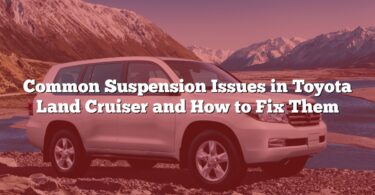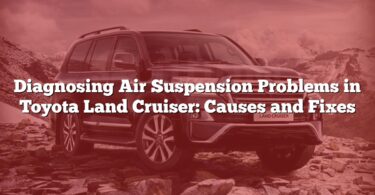Driving should be smooth and seamless, but jerking while behind the wheel of your Toyota Land Cruiser can disrupt the experience and signal underlying issues. From fuel system problems to transmission troubles, understanding the causes is the first step toward resolving them. This guide breaks down the 37 most common reasons for jerking and provides clear, practical solutions to help you get back to a worry-free drive.
Problems and Solutions for Jerking While Driving in a Toyota Land Cruiser
| N° | Problem/Cause | Solution |
|---|---|---|
| 1 | Dirty or clogged fuel injectors | Clean or replace fuel injectors. |
| 2 | Faulty spark plugs | Replace faulty spark plugs. |
| 3 | Worn ignition coils | Replace ignition coils. |
| 4 | Contaminated or low-quality fuel | Drain and refill with high-quality fuel. |
| 5 | Failing fuel pump | Test and replace the fuel pump if necessary. |
| 6 | Malfunctioning mass air flow (MAF) sensor | Clean or replace the MAF sensor. |
| 7 | Blocked or dirty air filter | Replace the air filter. |
| 8 | Throttle body issues | Clean or repair the throttle body. |
| 9 | Transmission problems | Inspect and service the transmission; replace fluid if needed. |
| 10 | Worn-out clutch | Replace the clutch. |
| 11 | Faulty oxygen sensor | Replace the oxygen sensor. |
| 12 | Dirty or faulty EGR valve | Clean or replace the EGR valve. |
| 13 | Vacuum leaks | Locate and seal any vacuum leaks. |
| 14 | Faulty catalytic converter | Replace or clean the catalytic converter. |
| 15 | Loose or damaged fuel lines | Inspect and repair or replace fuel lines. |
| 16 | Sensor failures (e.g., crankshaft or camshaft position sensors) | Diagnose and replace the faulty sensor. |
| 17 | Electrical wiring issues | Inspect and repair damaged wiring or connections. |
| 18 | Faulty fuel pressure regulator | Replace the fuel pressure regulator. |
| 19 | Overheating engine | Check cooling system; repair leaks or replace coolant. |
| 20 | Faulty ECU (Engine Control Unit) | Reprogram or replace the ECU. |
| 21 | Excessive carbon buildup in the engine | Perform engine cleaning or decarbonization. |
| 22 | Failing drivetrain components | Inspect and replace worn drivetrain parts. |
| 23 | Malfunctioning turbocharger | Repair or replace the turbocharger. |
| 24 | Differential or transfer case issues | Inspect and repair or replace components. |
| 25 | Misaligned wheels or worn suspension components | Align wheels and replace worn suspension parts. |
| 26 | Bad wheel bearings | Replace damaged wheel bearings. |
| 27 | Worn or damaged tires | Replace or repair tires; check alignment. |
| 28 | Engine misfires | Diagnose and fix ignition or fuel system issues. |
| 29 | Faulty speed sensor | Replace the faulty speed sensor. |
| 30 | Poor or delayed gear shifting | Inspect the transmission and adjust or repair as needed. |
| 31 | Damaged cylinders | Repair or replace damaged cylinders. |
| 32 | Fuel blockages | Clean or replace clogged fuel lines or components. |
| 33 | Blocked catalytic converters | Use a cleaner or replace the catalytic converter. |
| 34 | Damaged gas lines | Repair or replace damaged gas lines. |
| 35 | Damaged acceleration cables | Replace the acceleration cable. |
| 36 | Defective carburetors | Clean or rebuild the carburetor. |
| 37 | Moisture on the distributor cap | Dry the distributor cap or store the car in a warm location. |
Detailed Guide : Problems and Solutions for Jerking While Driving in a Toyota Land Cruiser
1. Dirty or Clogged Fuel Injectors
Dirty or clogged fuel injectors disrupt the smooth flow of fuel into the engine, causing jerking. Over time, carbon deposits and debris can accumulate, leading to uneven fuel delivery.
Solution:
- Use a fuel injector cleaner additive to remove minor clogs.
- For severe cases, remove the fuel injectors and have them professionally cleaned or replaced.
2. Faulty Spark Plugs
Worn or damaged spark plugs fail to ignite the air-fuel mixture properly, resulting in misfires and jerking.
Solution:
- Inspect the spark plugs for signs of wear, damage, or fouling.
- Replace the spark plugs with ones specified by the vehicle manufacturer.
3. Worn Ignition Coils
Ignition coils supply the high voltage necessary to ignite the fuel. If they wear out, the ignition system may fail intermittently, causing jerking.
Solution:
- Test the ignition coils using a multimeter.
- Replace any faulty ignition coils.
4. Contaminated or Low-Quality Fuel
Low-quality or contaminated fuel disrupts engine combustion and leads to jerking.
Solution:
- Drain the fuel tank and refill with high-quality fuel.
- Consider adding a fuel stabilizer to improve fuel quality.
5. Failing Fuel Pump
A failing fuel pump cannot maintain consistent fuel pressure, leading to jerking during acceleration.
Solution:
- Test the fuel pump pressure using a fuel pressure gauge.
- Replace the fuel pump if it is unable to maintain the required pressure.
6. Malfunctioning Mass Air Flow (MAF) Sensor
The MAF sensor measures incoming air for proper fuel mixture. A faulty sensor causes incorrect fuel delivery, leading to jerking.
Solution:
- Remove the MAF sensor and clean it using a specialized MAF sensor cleaner.
- If cleaning doesn’t resolve the issue, replace the sensor.
7. Blocked or Dirty Air Filter
A clogged air filter restricts airflow, making it difficult for the engine to operate efficiently.
Solution:
- Replace the air filter with a new one.
- Regularly inspect and clean the air filter every 12,000 to 15,000 miles.
8. Throttle Body Issues
A dirty or malfunctioning throttle body affects the air intake, causing jerking.
Solution:
- Remove the throttle body and clean it with throttle body cleaner.
- Reinstall and test for smooth performance.
9. Transmission Problems
Low or dirty transmission fluid and internal transmission wear can cause jerking during gear shifts.
Solution:
- Check the transmission fluid level and condition.
- Replace the fluid and filter if dirty.
- For severe issues, have the transmission inspected and repaired by a professional.
10. Worn-Out Clutch
In manual transmissions, a worn clutch can slip, causing jerking.
Solution:
- Replace the clutch plate, pressure plate, and release bearing.
11. Faulty Oxygen Sensor
A faulty oxygen sensor gives incorrect readings, leading to improper fuel-air mixture.
Solution:
- Replace the oxygen sensor based on the diagnostic trouble code (DTC).
12. Dirty or Faulty EGR Valve
A dirty EGR valve causes exhaust gas recirculation issues, leading to jerking.
Solution:
- Remove the EGR valve and clean it thoroughly.
- Replace the valve if cleaning doesn’t resolve the issue.
13. Vacuum Leaks
A vacuum leak disrupts engine vacuum balance, affecting performance.
Solution:
- Inspect all vacuum hoses for cracks or disconnections.
- Replace any damaged hoses.
14. Faulty Catalytic Converter
A clogged or failing catalytic converter restricts exhaust flow, leading to jerking.
Solution:
- Use a catalytic converter cleaner to remove blockages.
- Replace the converter if the problem persists.
15. Loose or Damaged Fuel Lines
Leaking fuel lines cause inconsistent fuel flow.
Solution:
- Inspect the fuel lines for leaks or damage.
- Replace damaged fuel lines.
16. Sensor Failures (e.g., Crankshaft or Camshaft Position Sensors)
Sensor failures disrupt engine timing, causing jerking.
Solution:
- Use an OBD-II scanner to identify faulty sensors.
- Replace defective sensors.
17. Electrical Wiring Issues
Damaged wiring can disrupt critical engine signals.
Solution:
- Inspect and repair damaged wires and connectors.
- Ensure all connections are secure.
18. Faulty Fuel Pressure Regulator
A faulty regulator fails to maintain proper fuel pressure.
Solution:
- Test the regulator and replace it if defective.
19. Overheating Engine
An overheating engine causes inconsistent performance.
Solution:
- Inspect the cooling system for leaks.
- Replace the coolant and repair or replace faulty components.
20. Faulty ECU (Engine Control Unit)
A malfunctioning ECU disrupts engine control.
Solution:
- Reprogram or replace the ECU.
21. Excessive Carbon Buildup in the Engine
Carbon buildup affects combustion and engine efficiency.
Solution:
- Perform engine decarbonization using a professional cleaning solution.
22. Failing Drivetrain Components
Worn drivetrain parts cause vibrations and jerking.
Solution:
- Inspect and replace worn-out drivetrain components.
23. Malfunctioning Turbocharger
A failing turbocharger causes inconsistent air delivery to the engine.
Solution:
- Inspect the turbocharger for damage or wear.
- Repair or replace the turbocharger if necessary.
24. Differential or Transfer Case Issues
Issues in the differential or transfer case cause jerking, especially in 4WD systems.
Solution:
- Inspect the differential and transfer case for damage or wear.
- Replace or repair any faulty components.
25. Misaligned Wheels or Worn Suspension Components
Misaligned wheels or damaged suspension parts lead to instability and jerking.
Solution:
- Perform a wheel alignment.
- Replace worn suspension components such as bushings or struts.
26. Bad Wheel Bearings
Damaged wheel bearings cause vibrations that feel like jerking.
Solution:
- Inspect each wheel bearing for play or noise.
- Replace any damaged bearings.
27. Worn or Damaged Tires
Uneven tire wear or damaged tires affect vehicle stability.
Solution:
- Inspect tires for wear or damage.
- Replace or repair tires and ensure proper alignment.
28. Engine Misfires
Misfires occur due to ignition or fuel delivery problems, causing jerking.
Solution:
- Diagnose the cause of misfires using an OBD-II scanner.
- Address the issue by replacing faulty spark plugs, coils, or fuel components.
29. Faulty Speed Sensor
A faulty speed sensor disrupts transmission and engine timing.
Solution:
- Use a diagnostic scanner to confirm the faulty sensor.
- Replace the speed sensor.
30. Poor or Delayed Gear Shifting
Improper gear shifting in automatic transmissions leads to jerking.
Solution:
- Check and replace the transmission fluid if dirty.
- Inspect the transmission for internal damage and repair as needed.
31. Damaged Cylinders
Cracked or damaged engine cylinders cause misfires and jerking.
Solution:
- Conduct a compression test to identify damaged cylinders.
- Repair or replace the affected cylinders.
32. Fuel Blockages
Blocked fuel lines or filters prevent smooth fuel delivery.
Solution:
- Replace the fuel filter and clean fuel lines.
33. Blocked Catalytic Converters
A severely blocked catalytic converter causes engine power loss and jerking.
Solution:
- Use a catalytic converter cleaner for mild blockages.
- Replace the converter if cleaning doesn’t work.
34. Damaged Gas Lines
Leaks or damage in the gas lines cause inconsistent fuel pressure.
Solution:
- Inspect the gas lines for leaks or corrosion.
- Replace any damaged sections.
35. Damaged Acceleration Cables
A damaged acceleration cable restricts throttle movement, leading to jerking.
Solution:
- Inspect the cable for fraying or damage.
- Replace the cable if necessary.
36. Defective Carburetors
A faulty carburetor mixes air and fuel improperly, causing jerking.
Solution:
- Disassemble and clean the carburetor with a specialized cleaner.
- Rebuild or replace the carburetor if necessary.
37. Moisture on the Distributor Cap
Moisture causes electrical interference, leading to jerking.
Solution:
- Remove the distributor cap and dry it thoroughly.
- Avoid parking in damp or cold environments, or use a car cover in winter.
Preventing Future Issues
To ensure your Toyota Land Cruiser runs smoothly and to avoid future jerking issues, it’s essential to adopt a proactive maintenance approach. Follow these steps to maintain your vehicle’s health:
- Regular Maintenance Schedule
- Adhere to your vehicle’s recommended maintenance schedule as outlined in the owner’s manual.
- Schedule regular check-ups for key components like the fuel system, ignition system, and transmission.
- Use High-Quality Fuel and Fluids
- Always use high-quality fuel from reputable stations to avoid contaminants.
- Regularly check and replace engine oil, transmission fluid, and coolant as per manufacturer recommendations.
- Replace Filters on Time
- Replace the air filter every 12,000 to 15,000 miles or as needed.
- Ensure the fuel filter is replaced at the recommended interval to maintain proper fuel flow.
- Inspect Tires and Wheels
- Perform regular tire rotations and wheel alignments to prevent uneven wear.
- Check for any damage or bald spots on the tires.
- Keep Sensors and Electronics in Check
- Use an OBD-II scanner periodically to detect potential issues early.
- Ensure all engine sensors, such as MAF, oxygen sensors, and speed sensors, are functioning correctly.
- Clean and Protect Components
- Clean the throttle body, fuel injectors, and EGR valve at regular intervals to prevent carbon buildup.
- Protect electrical components like the distributor cap from moisture, especially during winter.
- Drive Responsibly
- Avoid aggressive acceleration and braking, which can strain the engine, transmission, and drivetrain.
- Allow the engine to warm up before driving in cold conditions to reduce wear on components.
- Monitor Warning Signs
- Pay attention to unusual noises, vibrations, or dashboard warning lights.
- Address minor issues promptly to prevent them from escalating into major problems.
- Work with Professionals
- Have your vehicle inspected by a trusted mechanic for complex issues or scheduled maintenance.
- Keep a record of all maintenance and repairs to track the health of your vehicle.
By following these steps, you can prevent many common issues, ensuring a smoother and more reliable driving experience while extending the life of your Toyota Land Cruiser.







